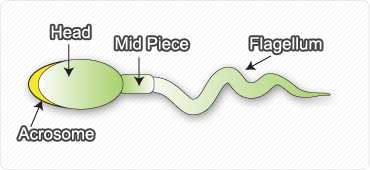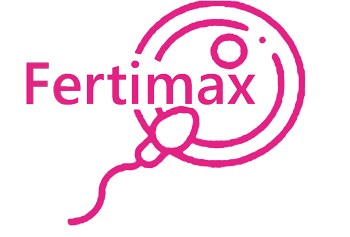Male fertility
Sperm is produced by ejaculation during intercourse and is made up of approximately:
- 20% spermatozoa. One millilitre of sperm contains between 50 and 150 million spermatozoa.
- 70% fluid from the seminal vesicles. This fluid contains fructose which provides the spermatozoa with the fuel they require to swim towards the ovum.
- 10% fluid from the prostate and Cowper glands, which helps to neutralise the acidity in the woman's vagina.
 In contrast to a woman, who is born with all the ova she will have during her lifetime, a man constantly produces new spermatozoa. His store of spermatozoa is renewed roughly every 72 days. A man produces almost 100 million spermatozoa per day.
In contrast to a woman, who is born with all the ova she will have during her lifetime, a man constantly produces new spermatozoa. His store of spermatozoa is renewed roughly every 72 days. A man produces almost 100 million spermatozoa per day.
Between the moment the sperm is ejaculated and the moment the ovum is fertilised, the spermatozoa will first have to climb the mucus that is present on the cervix at the time of ovulation, then swim up the Fallopian tubes using their flagellum. Considering the size of a spermatozoon (0.07 mm long), this would be the equivalent of a human travelling from the earth to the moon. The swimmers travel at 50 micrometres per second. The journey will take the most agile spermatozoa 45 minutes, whereas the slowest will need 12 hours.
 Several tens of millions of spermatozoa arrive at the cervical mucus but only a few thousand of them will make it to within range of the ovum and only one will finally manage to fertilise the oocyte. This selection depends on the spermatozoon's ability to move (its motility) but also on its morphology which allows it to pass without difficulty through the filtering mesh of the cervical mucus.
Several tens of millions of spermatozoa arrive at the cervical mucus but only a few thousand of them will make it to within range of the ovum and only one will finally manage to fertilise the oocyte. This selection depends on the spermatozoon's ability to move (its motility) but also on its morphology which allows it to pass without difficulty through the filtering mesh of the cervical mucus.
When they reach the ovum, the surviving spermatozoa try to forge a path for themselves. To do this, they hit the surface of the ovum with their acrosome. This mini chemical bomb made up of active enzymes dissolves a part of the ovum's protective outer layer to create an opening. The chosen spermatozoon threads its way inside, whipping about with its flagellum. Once it has penetrated the ovum, the door closes again to prevent any other spermatozoon from entering.
Inside the ovum, the genetic material contained in the head of the spermatozoon merges with that of the ovum. The following day, 23 pairs of chromosomes are formed by 23 chromosomes from the ovum combining with 23 chromosomes from the spermatozoon. The embryo is born. After eight weeks, the embryo will become a ftus. And your child will arrive seven months later.
